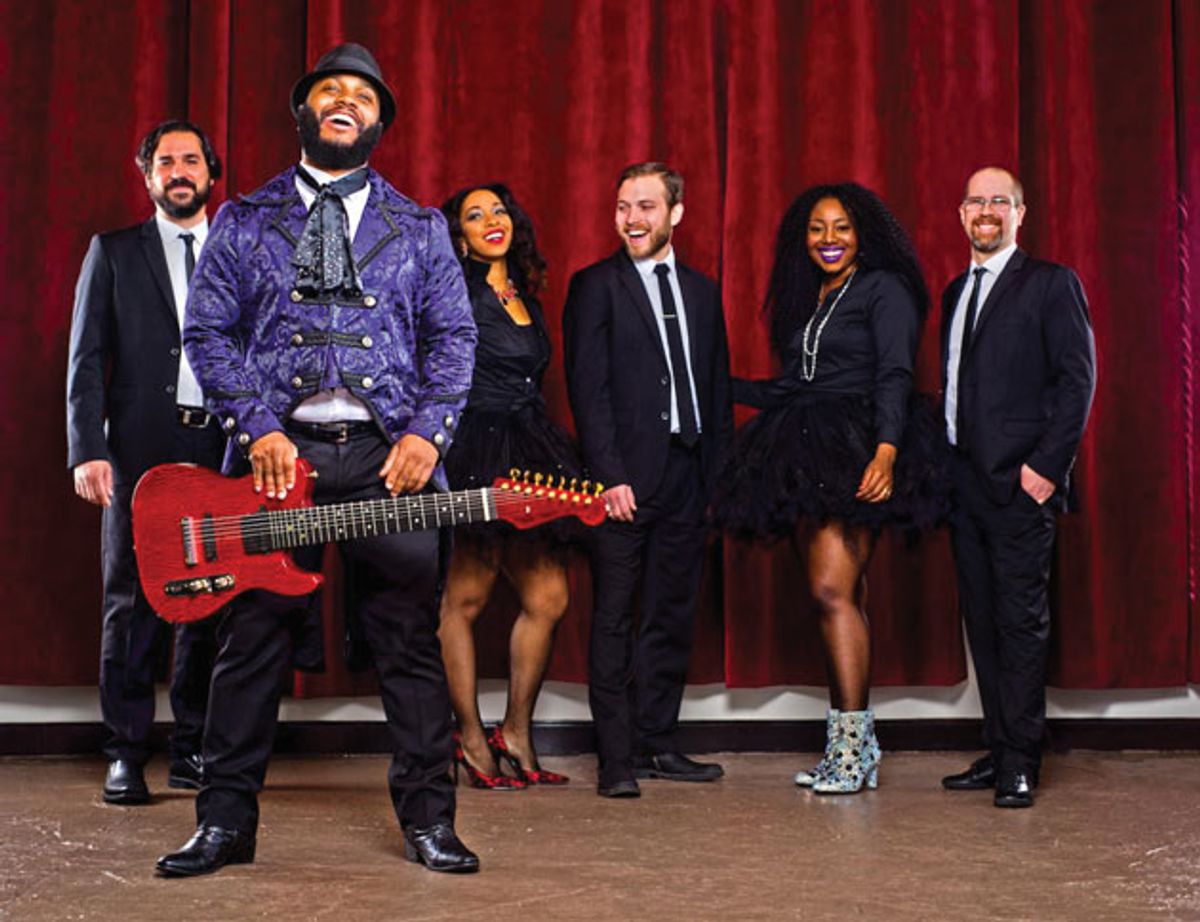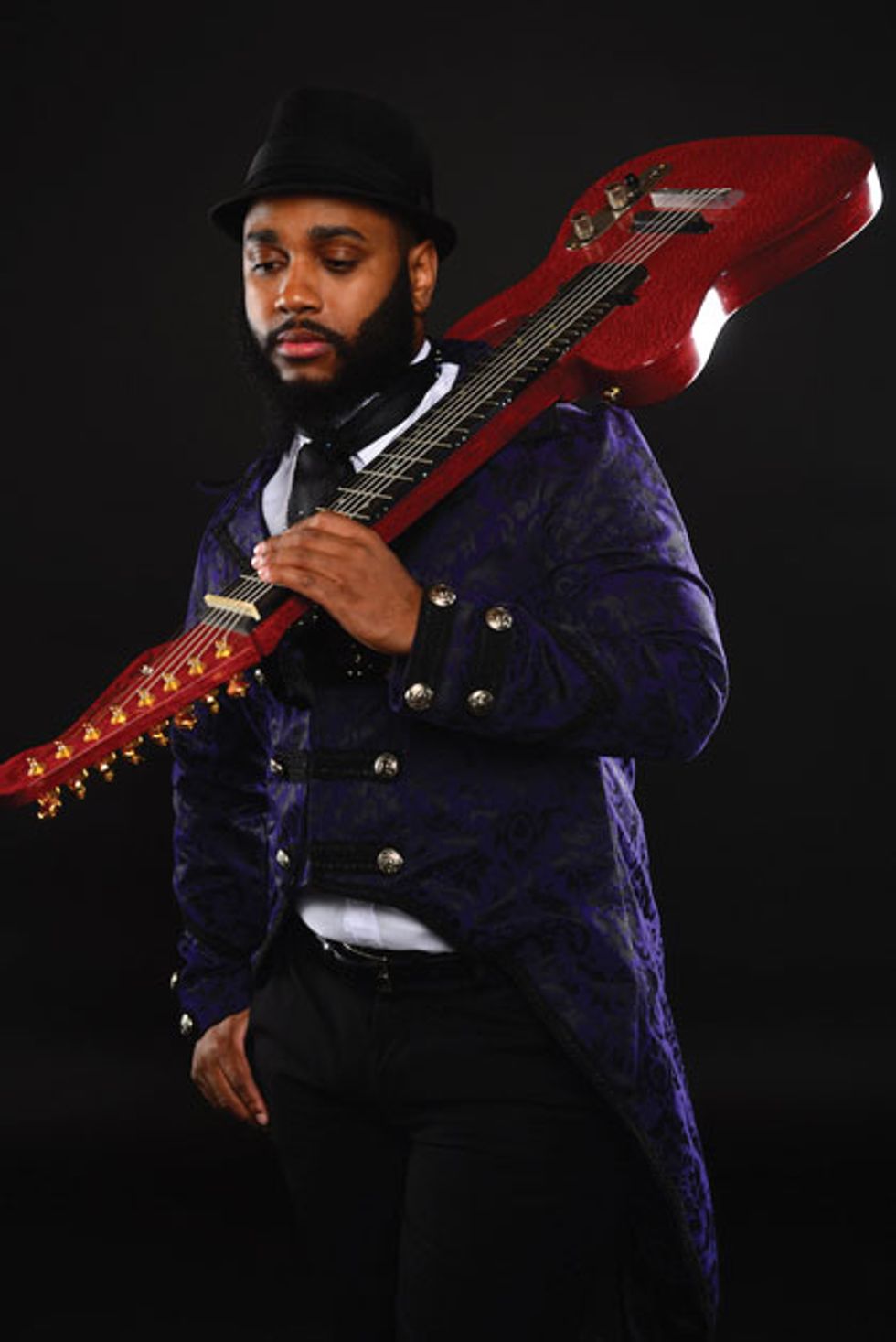From sanctified beginnings to high-energy secular soul, this steel guitarist forged his own way.
AJ Ghent was born to the “sacred steel” tradition, where gospel music is accompanied and played instrumentally on lap and pedal steel guitars. AJ’s father, Aubrey Ghent, great uncle, Willie Eason, and grandfather, Henry Nelson, are all pioneers of the sacred steel sound. Though AJ was first exposed to steel guitar in church, over the years he has developed a potent take on Southern soul and R&B.
From his birthplace in Florida, Ghent moved to Atlanta, Georgia, where he played in Top 40 bands. Later, he joined up with Col. Bruce Hampton, the legendary eccentric best known as the leader of such experimental groups as Aquarium Rescue Unit and Codetalkers. Along the way, Ghent developed a style of playing steel standing up, using an “over hand” slide technique.
Now he’s out in front of his own group, which features his wife MarLa and sister Tiffany on backing vocals, Gary Paulo on saxophone and guitar, bassist Seth Watters, and Will Groth on drums. Their CD/DVD Live at Terminal West fully captures all the raw energy of the band’s stage show.
In a brief respite from the road, Ghent spoke to Premier Guitar about his church beginnings (and endings), as well as the evolution of his unique playing style and the custom instruments that go along with it.
Did you start on regular guitar or steel?
I started on drums, but went straight from there to lap steel. I learned from listening to my father, grandfather, great-uncle, and from CDs.
Did you begin playing in church?
I played in my room for a long time. A member of the church we attended heard I’d started on lap steel and invited me to some of the programs. I played in church regularly for a couple of years. As I got a little older, they saw me emerging into a Hendrix style and kicked me out.
Your style of playing actually became an issue?
It wasn’t necessarily the playing. I always had a sense of freedom—I wanted to express myself. In that organization, clothing needed to be as simple as possible. I would come in with a big, red Afro and a suit. I was the Liberace of the church at the time.
Where did you play after church?
My first gig in the clubs was with a Top 40 band. I was playing R&B, rock, hip hop, pop music—anything that was on the radio. Playing everything helped groom me for my style today.
AJ Ghent's Gear
Guitars
Custom 8-string T-style steel guitar
Converted Fender Select Carve Top Jazzmaster
Amps
Andrews Amp Labs Spectraverb through a Forte 3D cab with an EVM 12L speaker
Effects
J. Rockett Audio Designs Archer OD/Boost
Chicago Iron Octavia fuzz
Real McCoy Custom and Dunlop Cry Baby wahs
Xotic SL Drive and EP Booster
MXR Carbon Copy Analog Delay
Skreddy Pedals Echo
Strings and Picks
6-string guitar: D'Addario EJ22 (.013-.056)
8-string guitar: custom D'Addario set (.015-.064)
Dunlop fingerpicks and thumbpick
Ernie Ball glass slide
Were you playing a “sit-down” lap steel?
Yes, but I started standing up after I stopped playing in the Top 40 band. I wanted to move around more. I was playing lap steel, but I wanted to look like Jimi Hendrix and Stevie Ray Vaughan, or whoever was playing regular guitar standing up. I thought that looked so cool. Wayne Rogers, who was at Gold Tone at the time, told me they
had this lap steel that was like the old Oahu style. He said, “You can strap this thing around your
neck and play!” I wanted to play it like a Dobro, where you strap it on and it still faces you like a table. But we couldn’t get it to stay up like that—it kept falling
flat against my stomach, like a regular guitar. I thought, “This looks cool!” I continued to play like that and have been doing it ever since.
Was it much of an adjustment to switch from sitting to standing up, playing parallel with
your body?
It was huge! It’s not something you discover on Monday and then go to the nearest open jam and try it on Tuesday. I almost had to start learning to play all over again. I couldn’t see my frets the way
I could when they faced me, like on a lap steel. I
had marks on the side of the neck, like a traditional guitar, which I could see. I look at those to determine where I am, but lots of times I’m playing with my eyes closed, so I really depend on my ear. It definitely took a little time. When I adapted to it, though, it felt more comfortable than sitting down.
Some of your licks seem influenced by classic lead guitarists, rather than steel players. Who influenced you?
I started listening to a little bit of Hendrix, Stevie Ray Vaughan, and James Brown’s guitarists—that’s Guitar 101. Lately, I’ve been listening to Eric Gales—he’s just phenomenal. Eric Johnson was one of my favorites, as well. I’m always trying to mimic the guitar, listening to what they’re doing and trying to apply it to what I do.
AJ Ghent plays steel standing up, using a modified Dobro technique. With the guitar lying flat against his body, his left hand reaches over the neck from above to bring the tone bar in contact with the strings.
Gary Paulo largely handles the rhythm chores in your band. Is this because the steel doesn’t lend itself to that kind of playing, or is it so you can concentrate on singing?
It’s more to concentrate on singing. When I’m singing and playing at the same time, the tuning can drift off. I have to focus. My secret is to place the microphone so my head points down and I can see what I’m doing. When we recorded our live album, I didn’t want to chance being out of tune or singing wrong notes. When I’m freed from singing, I try to chime in as far as the rhythm and chord progressions, but it’s a challenge doing that without looking directly at the guitar. I don’t know too many people singing and playing steel with the guitars flat to their body, so I don’t have anyone to watch and learn from.
Describe your guitar.
It’s like a Telecaster with eight strings and a really fat neck so I can raise the strings and play slide. A friend of mine made it. I told him I had this vision of a Strat, Tele, or Les Paul style guitar mixed with the lap steel. I helped design it and he built it for me. He’s not a known builder—he’s just a guy who knows how to use his hands. I gave him the idea, and he came back with a Telecaster-style guitar with a Macassar ebony fretboard and a lacewood top.
Where did you get the pickups?
The pickups are Lollars. They’re based off an old Fender Stringmaster lap steel because my grandfather was known for playing that guitar. I loved the sound, and my dad had the same type of pickups. I wanted to keep a tiny bit of the “sacred steel” influence from my family. Those particular pickups get closest to that sound.
How do you tune it?
It’s in open D, but I throw in E andB at the top. I tune certain strings up and down for different songs to help me be comfortable playing and singing at the same time. My 6-string is in open E.
Is the 6-string a standard guitar with a raised nut and bridge?
It is a Fender Select Carve Top Jazzmaster. I raised the strings a little bit, put a set of .012s or .013s on there, and tuned it open to E. That’s a heck of a tone with those guitars.
YouTube It
Ghent shows some fancy slide work on his converted Fender Select Carve Top Jazzmaster. His solo gets really interesting at 4:18.
What amp do you use?
For a while, I was using a ’64 Fender Super Reverb with heavy 10" speakers. I told my amp guy, Jeff Andrews, it wasn’t giving me everything I wanted. He had all these great things he could do, but I didn’t want to modify the amp that much. So, he said, “I have these amps. You can try them out.” I’ve been playing his amp ever since. It’s a 40-watt Andrews Amp Labs Spectraverb. I’m playing it through a Forte 3D cab with an EVM 12L speaker—it’s got panels on the side that are open, so you get both a closed-back and an open-back feel.
You use some pedals, don’t you?
A lot of times I use just a guitar and amp, but in situations where I want a little extra boost, I might use the J. Rockett Archer pedal. I’ve been using that with a Chicago Iron Octavia to get that fuzz thing going. On the recording I was using a Real McCoy Custom wah, though I love Dunlop Cry Babys too. I was also using an Xotic SL Drive and their EP Booster, as well as an MXR Carbon Copy delay or the Skreddy Echo.
I try to keep it simple, but my dad humbles me every now and then. I look at his rig and he’s plugging straight into a Twin Reverb. It shows me it’s okay to have all that great stuff, but don’t get so caught up in it that you can’t focus on playing.
YouTube It
AJ Ghent tears it up on his custom 8-string “stand-up lap steel” guitar.
What’s next for the AJ Ghent Band?
We’ll be working on an actual studio album. We want to be able to go in a studio and put a lot of our influences on it at a slower pace than, “5, 4, 3, 2, 1—go for it!” Other than the new album, it’s just heavy touring and running into other great bands and artists out there.


